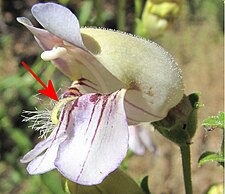Staminode: Difference between revisions
m Bot: Migrating 9 interwiki links, now provided by Wikidata on d:q2348006 (Report Errors) |
No edit summary |
||
| (10 intermediate revisions by 9 users not shown) | |||
| Line 1: | Line 1: | ||
{{short description|Modified or abortive stamen in flowering plants}} |
|||
| ⚫ | In [[botany]], a '''staminode''' is an often rudimentary, sterile or abortive [[stamen]] |
||
{{One source|date=January 2023}} |
|||
| ⚫ | In [[botany]], a '''staminode''' is an often rudimentary, sterile or abortive [[stamen]], which means that it does not produce [[pollen]].<ref name= "BotGloss">Jackson, Benjamin, Daydon; ''A Glossary of Botanic Terms with their Derivation and Accent''; Published by Gerald Duckworth & Co. London, 4th ed 1928</ref> Staminodes are frequently inconspicuous and stamen-like, usually occurring at the inner whorl of the flower, but are also sometimes long enough to protrude from the corolla. |
||
[[Image:Staminode 1509.JPG|thumb|right|225px|The arrow points to the hairy staminode of a Grinnell's Penstemon (''Penstemon grinellii'') flower]] |
[[Image:Staminode 1509.JPG|thumb|right|225px|The arrow points to the hairy staminode of a Grinnell's Penstemon (''Penstemon grinellii'') flower]] |
||
Sometimes, the staminodes are modified to produce [[nectar]], as in the |
Sometimes, the staminodes are modified to produce [[nectar]], as in the witch hazel ''([[Hamamelis]])''.<ref>jin lu mei shu. Hamamelis Linnaeus, Sp. Pl. 1: 124. 1753. Flora of China 9: 32. 2003</ref> |
||
Staminodes can be a critical characteristic for differentiating between species, for instance in the orchid genus ''[[Paphiopedilum]]'', and among the [[penstemon]]s. |
Staminodes can be a critical characteristic for differentiating between species, for instance in the orchid genus ''[[Paphiopedilum]]'', and among the [[penstemon]]s. |
||
In the case of [[Canna (plant)|Cannas]] the petals are inconsequential and the staminodes are refined into eye-catching petal-like replacements. |
In the case of [[Canna (plant)|Cannas]], the petals are inconsequential and the staminodes are refined into eye-catching petal-like replacements. |
||
A spectacular example of staminode is given by ''[[Couroupita guianensis]]'', a [[tropical tree]] growing in South America also known as the cannonball tree. |
|||
==References== |
==References== |
||
{{Reflist}} |
|||
<references /> |
|||
{{botany}} |
|||
[[Category:Plant anatomy]] |
[[Category:Plant anatomy]] |
||
[[ca:Estaminodi]] |
|||
[[de:Staubblatt#Modifikationen]] |
[[de:Staubblatt#Modifikationen]] |
||
Latest revision as of 17:52, 17 July 2024
This article relies largely or entirely on a single source. (January 2023) |
In botany, a staminode is an often rudimentary, sterile or abortive stamen, which means that it does not produce pollen.[1] Staminodes are frequently inconspicuous and stamen-like, usually occurring at the inner whorl of the flower, but are also sometimes long enough to protrude from the corolla.

Sometimes, the staminodes are modified to produce nectar, as in the witch hazel (Hamamelis).[2]
Staminodes can be a critical characteristic for differentiating between species, for instance in the orchid genus Paphiopedilum, and among the penstemons.
In the case of Cannas, the petals are inconsequential and the staminodes are refined into eye-catching petal-like replacements.
A spectacular example of staminode is given by Couroupita guianensis, a tropical tree growing in South America also known as the cannonball tree.
